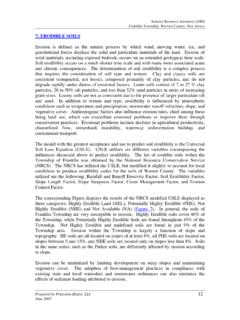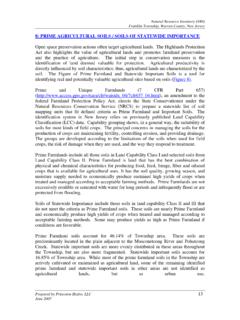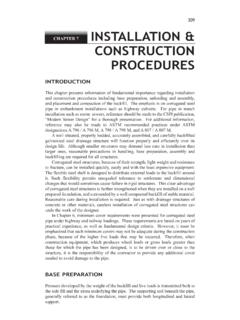Transcription of PRINCE GEORGE’S SOIL CONSERVATION DISTRICT
1 PRINCE george 'S. soil CONSERVATION DISTRICT . soil EROSION & SEDIMENT CONTROL . POND SAFETY REFERENCE MANUAL. JULY 2013. DRAFT. PRINCE george 's soil CONSERVATION DISTRICT 5301 Marlboro Race Track Road Upper Marlboro, MD 20772. Phone (301) 574-5162 Fax (301) 574-5156. INTRODUCTION. Dependence on the natural resources of Maryland is unending---and so is the need to protect our environment. The soil and water CONSERVATION program in Maryland, aimed at protecting soil and water resources, is the result of over 70 years of cooperative effort at the federal, state, and local levels. Under the State soil CONSERVATION DISTRICT 's Law, each Board of Supervisors is responsible for carrying out a soil and water CONSERVATION program to "provide for the CONSERVATION of the soil , water, and related resources of the state and for the control and prevention of soil erosion in order to preserve natural resources, control floods, prevent impairment of dams and reservoirs, assist in maintaining the navigability of rivers and harbors, preserve wildlife, protect the tax base, protect the public lands, protect and promote the health, safety, and general welfare of the people of the state, and otherwise enhance their living environment".
2 Acceptable erosion and sediment control plans must be designed to mitigate soil erosion, prevent increases in stormwater runoff, and minimize the discharge of pollutants. The Maryland Stormwater Management Act of 2007 and the 2011 Maryland Standards and Specifications for soil Erosion and Sediment Control requires the establishment of a comprehensive process for the review and approval of erosion and sediment control and stormwater management plans. A coordinated comprehensive review process includes the submission and review of erosion and sediment control and stormwater management plans for each of the following three phases of plan development: Concept Plan; Site Development Plan; and Final Plan. This manual is intended to be a reference guide for engineers, developers, reviewers, and inspectors who will be involved with design and implementation of erosion and sediment control practices and dam safety.
3 Existing references have been updated and consolidated into one document. As a service to our customers, we have attempted to simplify and clarify requirements from various sources. This manual will be used by our plan reviewers to ensure consistency in the plan review process and should be the basis for plan preparation and submittal by engineering consultants. The PRINCE george 's soil CONSERVATION DISTRICT prohibits discrimination in all its programs and activities on the basis of race, color, national origin, sex, religion, age, disability, political beliefs, sexual orientation, or marital or familial status. CONSERVATION DEVELOPMENT SELF-GOVERNMENT. i ACKNOWLEDGEMENTS. The latest revisions to the PRINCE george 's soil CONSERVATION DISTRICT soil Erosion and Sediment Control Pond Safety Manual, January 2013, are the result of the effort of the Erosion and Sediment Control Environmental Site Design Committee.
4 The committee consisted of members representing PRINCE george 's soil CONSERVATION DISTRICT (PGSCD), PRINCE george 's County Department of Public Works and Transportation (PGDPW&T), Maryland-National Capital Building Industry Association (BIA) and engineering consultant firms. Many individuals assisted with the revision to this document by providing review comments, suggestions, reference documents, and participation at committee meetings. We would like to acknowledge the following individuals for their invaluable contributions: We hope this consolidated and updated information will be helpful and encourage interested persons to contribute their experiences and knowledge in a continuing process of program improvement. ii Table of Contents Section I - PRINCE george 's soil CONSERVATION DISTRICT Concept Grading, Erosion and Sediment Control Plan (CSC). Page A. Introduction for Concept Grading, Erosion and Sediment Control Plans I-1-2.
5 B. Concept Grading, Erosion and Sediment Control Plan Design Considerations .. I-3-5. C Concept Grading, Erosion and Sediment Control Plan Preparation . I-6-7. D. soil Report Requirements . I-8. E. COMAR Highly Erodible Soils Map .. I-9-13. F. Highly Quality (Tier II) Waters I-15-16. G. Sediment Impairments and TMDLS . I-17-18. H. Concept Grading, Erosion and Sediment Control Plan Submittal .. I-19. I. PGSCD Concept Grading, Erosion and Sediment Control Fees .. I-20-21. J. Concept Grading, Erosion and Sediment Control Plan Approval I-22. K. PGSCD Concept Grading, Erosion and Sediment Control Approval Stamp I-23. L. PGSCD Concept Grading, Erosion and Sediment Control Transmittal Letter I-24. M. PGSCD Concept Grading, Erosion Sediment Control Site Analysis .. I-25. Section II PRINCE george 's soil CONSERVATION DISTRICT Environmental Site Development Grading, Erosion and Sediment Control Plan (SSC).
6 A. Introduction for Environmental Site Development Grading, Erosion and Sediment Control Plans II-1. B. Environmental Site Development Grading, Erosion and Sediment Control Plan Design Considerations . II-2-4. C. Environmental Site Development Grading, Erosion and Sediment Control Plan Preparation II-5-6. D. PGSCD Small Pond soil Reports and Borrow Areas II-7. E. PGSCD Dam Hazard Classification II-8-9. F. TR-66 Simplified Dam-Breach Routing Procedure II-10. G. Preliminary Pond Exemptions II-11-12. H. Maryland Average Rainfall from NOAA Atlas 14 .. II-13. I. Environmental Site Development Grading, Erosion and Sediment Control Plan Submittal II-14. J. PGSCD Environmental Site Development Grading, Erosion and Sediment Control Fees .. II-15-16. K. Environmental Site Development Grading, Erosion and Sediment Control Plan Approval II-17. L. PGSCD Environmental Site Development Grading, Erosion and Sediment Control Approval Stamp.
7 II-18-19. M. PGSCD Environmental Site Development Grading, Erosion and Sediment Control Transmittal Letter . II-20. N. PGSCD Environmental Site Development Grading, Erosion and Sediment Control Site Analysis II-21. iii SECTION I. PRINCE george 'S. soil CONSERVATION DISTRICT . CONCEPT. GRADING, EROSION AND. SEDIMENT CONTROL PLAN. ___ I. PRINCE george 'S soil CONSERVATION DISTRICT (PGSCD) CONCEPT GRADING, EROSION AND SEDIMENT CONTROL PLAN (CSC). ___A. INTRODUCTION FOR CONCEPT GRADING, EROSION AND SEDIMENT CONTROL. PLANS. ___1. The following guidelines are to be considered in the preparation of a Concept Grading, Erosion and Sediment Control Plan submitted to PGSCD for review and approval. All Concept Grading, Erosion and Sediment Control plans (CSC's), are to be in conformance with this document, the criteria established in the Code of Maryland Regulation Title 26, Subtitle 17, Chapter 01, the 2011 Maryland Standards and Specifications for soil Erosion and Sediment Control, (Standards and Specifications), or later revisions and Chapter 5 Environmental Design of the 2000 Maryland Stormwater Design Manual.
8 ___2. A comprehensive design strategy for maintaining predevelopment runoff characteristics and protecting natural resources is available. This strategy, known as Environmental Site Design or ESD, relies on integrating site design, natural hydrology, and small controls to capture and treat runoff. ___3. The primary goal is to maintain the natural hydraulic runoff of a site to predevelopment runoff characteristics to the maximum extent practicable after development. ___4. Designers must develop plans that are designed to: ____ a. Prevent soil erosion from development projects. ____ b. Prevent increases in nonpoint pollution. ____ c. Minimize pollutants in stormwater runoff from both new development and redevelopment. ____ d. Restore, enhance, and maintain chemical, physical, and biological integrity of receiving waters to protect public health and enhance domestic, municipal, recreational, industrial and other uses of water as specified by MDE.
9 ____ e. Maintain 100% of the average annual predevelopment groundwater recharge volume. ____ f. Capture and treat stormwater runoff to remove pollutants. ____ g. Implement a channel protection strategy to protect receiving streams. ____ h. Prevent increases in the frequency and magnitude of out-of-bank flooding from large, less frequent storms. ____ i. Protect public safety through the proper design of stormwater management facilities. ___ j. Preserve sensitive natural features. ___5. Environmental Site Design (ESD) is defined as using small-scale stormwater management practices, nonstructural techniques, and better site planning to mimic natural hydrologic runoff characteristics and minimize the impact of land development on water resources. This definition, includes: ____ a. Optimizing CONSERVATION of natural features ( , drainage patterns, soil , vegetation, steep slopes and highly erodible soils).
10 ____ b. Minimizing impervious surfaces ( , pavement, concrete channels, roofs). ____ c. Slowing down runoff to maintain discharge timing and to increase infiltration and evapotranspiration. ____ d. Using other nonstructural practices or innovative technologies approved by MDE. ___6. The goal of traditional site design strategies has been to maximize development potential by focusing on the layout of buildings, roads, parking, and other features. Conventional development practices tend to maximize site imperviousness and contribute to many undesired impacts. These include the undesired effects of diminished groundwater recharge, increased flows and runoff volumes, pollutant accumulation, and elevated water temperatures. I-1. ___7. Stream quality and watershed health diminish when impervious cover exceeds 10% and become severely degraded beyond 25% (Center for Watershed Protection, 2003).






